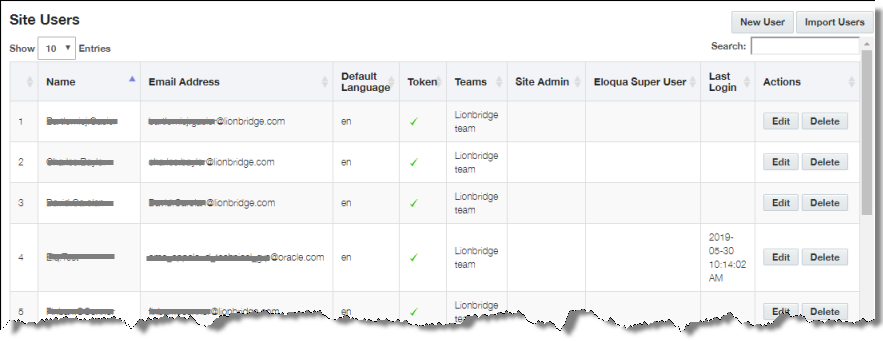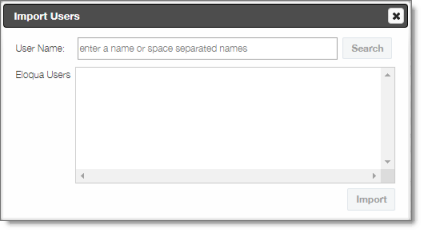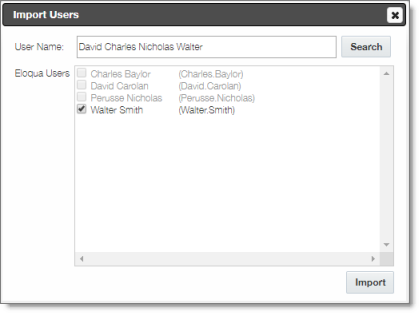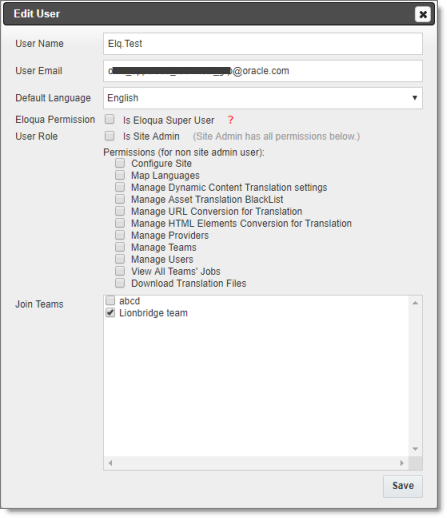Managing Users
Eloqua users can access Lionbridge App to send, monitor, and review translation jobs.
Important: Before setting up users and teams, read Configuring User Access.
To manage users:
- In the Site Administration menu on the left, click Site Users.
The Site Users page opens, displaying the users set up for your Oracle Eloqua site.

This page displays the following information about each user:
| Column |
Description |
| Name |
The name of the user. |
| Email Address |
The email address of the user. |
| Default Language |
The default language in which the Lionbridge App interface is displayed for the user. If the user is a site administrator, who can access the functionality described in this guide, then this is the language in which the CloudBroker interface is displayed for this user. |
| Token |
A checkmark indicates whether this user has an active token for authentication to Eloqua. |
| Teams |
The teams to which this user belongs. The team determines which source and target languages the user can send out for translation and the translation providers to which the user can send the content. |
| Site Admin |
A checkmark indicates whether this user is a site administrator. Site administrators can access CloudBroker to set up the Lionbridge App, as described in this guide. |
| Eloqua Super User |
A checkmark indicates whether this user is an Eloqua superuser. If a user who submitted a translation job does not have sufficient permissions to return the translated content to Eloqua, then the App uses the Eloqua superuser’s credentials to return translated content to Eloqua. |
| Last Login |
The time and date when the user last logged into the App, in the following format: YYYY-MM-DD hh:mm:ss AM/PM.. |
- Do one of the following:
- To create a new user, click New User. For detailed instructions, see Adding a User.
- To import users, click Import Users. For detailed instructions, see Importing Users.
- To edit a user, in the Actions column, click Edit in the corresponding row. For detailed instructions, see Editing a User.
- To delete a user, in the Actions column, click Delete in the corresponding row. For detailed instructions, see Deleting a User.
1 - Importing Users
You import users from Oracle Eloqua to the Lionbridge App so that you can add them to teams, which enables them to send assets for translation from and to specified languages and to specified translation providers. This is the best way to add many Oracle Eloqua users to the Lionbridge App without adding all the users to the App.
Important: Before setting up users and teams, read Configuring User Access.
To import users:
- In the Site Administration menu on the left, click Site Users.
The Site Users page opens, displaying the users set up for your Oracle Eloqua site. For detailed information about this page, see Managing Users.
- Click Import Users.
A dialog box may open, prompting you to log in to Oracle Eloqua.

- If the dialog box opens, enter your Oracle Eloqua credentials, and click Login.
The Import Users dialog box opens.

- In the User Name field, enter one or more names or partial names of the users to import, and click Search.
The Eloqua Users box displays all matching Eloqua users.

Note: If an Eloqua user is already in the Lionbridge App, that user is displayed in grey, and the corresponding check box is not available for selection.
- Select the check boxes for the users to import into the Lionbridge App, and then click Import.
The Lionbridge App imports each selected user’s username and email address. During the import process, the App automatically overwrites the records of any users with matching email addresses. This prevents duplicate user records in the App.
Note: After users are imported, you still need to add them to a team, so that they can send out assets for translation. You can also specify which users are site administrators, who can access configuration and administration features in the Lionbridge App, and you can specify the default language for displaying the Lionbridge App to each user. For details, see the following section, Editing a User.
2 - Editing a User
In general you edit a user that you previously added, either by importing or automatically, to specify the following information:
- the default language for displaying the Lionbridge App for the user
- whether the user is a site administrator, who can access CloudBroker to set up the Lionbridge App, as described in this guide
- the teams that the user joins
You can also change a user’s username or email address.
To edit a user:
- In the Site Administration menu on the left, click Site Users.
The Site Users page opens, displaying the users set up for your Oracle Eloqua site. For detailed information about this page, see Managing Users.
- Click Edit for the user to edit.
The Edit Userdialog box opens.

- You can modify the following information:
| Field |
Description |
| User Name |
The user’s username. This must be the same as the user’s username for accessing Oracle Eloqua. |
| User Email |
The user’s email address. |
| Default Language |
In the dropdown list, select the default language in which the Lionbridge App interface is displayed for the user. If the user is a site administrator, who can access the functionality described in this guide, then this is the language in which the CloudBroker interface is displayed for this user. Languages are configured in CloudBroker by the Lionbridge Connector Team. For more information, please contact Lionbridge Connector Support, as described in How to Contact Lionbridge Connector Support. |
| Eloqua Permission |
Indicates whether this user is an Eloqua superuser. If a user who submitted a translation job does not have sufficient permissions to return the translated content to Eloqua, then the App uses the Eloqua superuser’s credentials to return translated content to Eloqua.
* If the user is an Eloqua superuser, select the Is Eloqua Super User check box.
* If the user is not an Eloqua superuser, clear the **Is Eloqua Super User** check box. |
| User Role |
Indicates whether this user is a site administrator, who can access CloudBroker to set up the Lionbridge App, as described in this guide.
* If the user is a site administrator, select the **Is Site Admin** check box.
* If the user is not a site administrator, clear the Is Site Admin check box.
If the user is not a site administrator, you can grant the following administrative permissions to the user by selecting the corresponding check boxes:
* **Configure Site**: configure your site, in the Site Configuration dialog box.
* **Map Languages**: configure language mappings, in the Language Mapping dialog box.
* **Manage Dynamic Content Translation settings**: configure translation settings for dynamic content, in the Site Extension dialog box.
* **Manage Providers**: configure translation providers, in the Site Providers page.
* **Manage Teams**: manage teams, in the Site Teams page.
* **Manage Users**: manage users, in the Site Users page.
* **View All Teams' Jobs**: view the translation jobs for all teams, in the Site Jobs page. Otherwise, the user can view jobs only for the teams to which the user is assigned.
* **Download Translation Files**: download source and target XML translation files, in the Job Details tab of the Translation Jobs page. |
| Join Teams |
The teams to which this user belongs. A user must belong to at least one team to be able to send out content for translation. The team determines which source and target languages the user can send out for translation and the translation providers to which the user can send the content.
You can view the settings for all teams on the Site Teams page. For details, see Managing Teams.
* To join a team, select the corresponding check box.
* To leave a team, clear the corresponding check box. |
- Click Save to save your changes.
3 - Adding a User
You can individually add an Oracle Eloqua user to the Lionbridge App so that you can add the user to one or more teams. This enables the user to send assets for translation from and to specified languages and to specified translation providers.
Individually adding an Oracle Eloqua user to the Lionbridge App is useful if you want only a few Oracle Eloqua users to access it.
Important: Before setting up users and teams, read Configuring User Access.
To add a user:
- In the Site Administration menu on the left, click Site Users.
The Site Users page opens, displaying the users set up for your Oracle Eloqua site. For detailed information about this page, see Managing Users.
- Click New User.
The New User dialog box opens.

- Enter the following information to identify the new user:
| Field |
Description |
| User Name |
Enter the user’s username for accessing the Lionbridge App. This must be exactly the same as the user’s username for accessing Oracle Eloqua. It is not case sensitive. |
| User Email |
Enter the user’s email address. This must be exactly the same as the user’s email address for accessing Oracle Eloqua. It is not case sensitive. |
- Click Verify. The App checks whether there are any users with the same or similar name already in Eloqua.
- If the App finds one user with the same or a similar name in Eloqua, it updates the record with the name and email address specified here. The Add button, described below, is enabled.
- If the App finds multiple users with similar names in Eloqua, it uses the email address specified here to match with the correct user. It then updates the record with the name specified here. The Add button, described below, is enabled.
- If the App does not find a user with a similar name in Eloqua, the Add button, described below is not enabled.
Recommendation: Add the user to Eloqua before adding the user to the App. Alternatively, after adding the user to Eloqua, import the user to the App. For detailed instructions, see Importing Users.
- If the App finds a user with the same or a similar name in Eloqua, but this user already exists in the App, then the Add button, described below, is not enabled.
- Enter the following additional information about the new user:
| Field |
Description |
| Default Language |
In the dropdown list, select the default language in which the Lionbridge App interface is displayed for the user. If the user is a site administrator, who can access the functionality described in this guide, then this is the language in which the CloudBroker interface is displayed for this user. Languages are configured in CloudBroker by the Lionbridge Connector Team. For more information, please contact Lionbridge Connector Support, as described in How to Contact Lionbridge Connector Support. |
| Eloqua Permission |
Indicates whether this user is an Eloqua superuser. If a user who submitted a translation job does not have sufficient permissions to return the translated content to Eloqua, then the App uses the Eloqua superuser’s credentials to return translated content to Eloqua.
* If the user is an Eloqua superuser, select the **Is Eloqua Super User** check box.
* If the user is not an Eloqua superuser, clear the **Is Eloqua Super User** check box. |
| User Role |
Indicates whether this user is a site administrator, who can access CloudBroker to set up the Lionbridge App, as described in this guide.
* If the user is a site administrator, select the **Is Site Admin** check box.
* If the user is not a site administrator, clear the **Is Site Admin** check box.
If the user is not a site administrator, you can grant the following administrative permissions to the user by selecting the corresponding check boxes:
* **Configure Site**: configure your site, in the **Site Configuration** dialog box.
* **Map Languages**: configure language mappings, in the **Language Mapping** dialog box.
* **Manage Dynamic Content Translation settings**: configure translation settings for dynamic content, in the **Site Extension** dialog box.
* **Manage Providers**: configure translation providers, in the **Site Providers** page.
* **Manage Teams**: manage teams, in the **Site Teams** page.
* **Manage Users**: manage users, in the **Site Users** page.
* **View All Teams' Jobs**: view the translation jobs for all teams, in the **Site Jobs** page. Otherwise, the user can view jobs only for the teams to which the user is assigned.
* **Download Translation Files**: download source and target XML translation files, in the **Job Details** tab of the Translation Jobs page. |
| Join Teams |
Select the check boxes of the teams the user is joining. A user must belong to at least one team to be able to send out content for translation. The team determines which source and target languages the user can send out for translation and the translation providers to which the user can send the content.
You can view the settings for all teams on the Site Teams page. For details, see Managing Teams. |
- Click Add.
4 - Deleting a User
You can delete a user from the Lionbridge App so that the user will no longer have access. Deleting a user from the Lionbridge App also deletes all the jobs and items sent by this user from the Lionbridge App .
Important: Deleting a user from the Lionbridge App does not delete the user in Oracle Eloqua.
To delete a user from the Lionbridge App:
- In the Site Administration menu on the left, click Site Users.
The Site Users page opens, displaying the users set up for your Oracle Eloqua site. For detailed information about this page, see Managing Users.
- In the Actions column, click Delete for the user to delete.
The Delete User dialog box opens.

The page displays the username and email address of the user to delete. It also displays the following information about the jobs and items this user sent for translation:
| Field |
Description |
| Total Jobs |
The total number of jobs this user sent out for translation. |
| Total Translation Items |
The total number of items this user sent out for translation. |
| Total Completed |
The total number of translated items that the Lionbridge App has re-imported into Eloqua. |
| Total Incomplete |
The total number of assets that the Lionbridge App has not yet re-imported into Oracle Eloqua. Usually these are assets that are currently in translation, or were just recently received back from translation and that the Lionbridge App is trying to re-import into Oracle Eloqua.
Warning: If you delete this user, these items will be deleted. They will not be re-imported into Oracle Eloqua. |
- Click Delete to remove the user and all the jobs and items sent out for translation by this user from the Lionbridge App.






